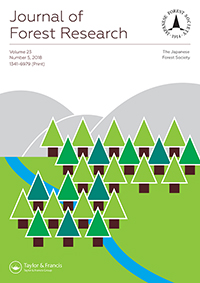View Item
- xmlui.general.dspace_homeCentros Regionales y EEAsCentro Regional Entre RíosEEA ParanáArtículos científicosxmlui.ArtifactBrowser.ItemViewer.trail
- DSpace Home
- Centros Regionales y EEAs
- Centro Regional Entre Ríos
- EEA Paraná
- Artículos científicos
- View Item
Effects of fire disturbance on bird communities and species of mountain Serrano forest in central Argentina
Abstract
In central Argentina, Serrano forest has a long history of fire disturbance; however, the impact of fire on avifauna remains unknown. We compared the avian–habitat relationships in forest patches with low, moderate, and high fire regimes using a community-level (species richness, abundance, ordination and guilds) and species-level (indicator species analysis) approach. In patches under each fire condition, we recorded bird community composition, richness
[ver mas...]
In central Argentina, Serrano forest has a long history of fire disturbance; however, the impact of fire on avifauna remains unknown. We compared the avian–habitat relationships in forest patches with low, moderate, and high fire regimes using a community-level (species richness, abundance, ordination and guilds) and species-level (indicator species analysis) approach. In patches under each fire condition, we recorded bird community composition, richness and abundance, and different vegetation structure variables. The site under high-severity fire regime was structurally poor and had been converted from original forest to dense grassland. There, diversity of bird community was low, retaining approximately 30 % of the species present in the least impacted site. Avian assemblage was dominated by generalist and open area birds. Guilds were underrepresented, showing an important reduction of foliage granivorous, nectarivorous, omnivores, and foliage and bark insectivorous, and absence of fly-catchers. Moreover, low abundance of forest understory, midstory, and canopy species and of birds belonging to open and closed nesting guilds was detected. By contrast, under low and moderate-severity fire regimes highest bird diversity as well as highest representativeness of most guilds was observed. Forest bird species were strongly associated with low fire disturbance, whereas moderate fire disturbance was characterized by the presence of forest and generalist species. Given the critical conservation status of Serrano forest in Córdoba, Argentina, habitat restoration and protection of forest relicts could be suitable measures to promote avifauna preservation.
[Cerrar]

Author
Albanesi, Sebastián;
Dardanelli, Sebastian;
Bellis, Laura Marisa;
Fuente
Journal of forest research 19 (1). (2014)
Date
2014
Editorial
Taylor & Francis
ISSN
1341-6979
1610-7403 (Online)
1610-7403 (Online)
Formato
pdf
Tipo de documento
artículo
Palabras Claves
Derechos de acceso
Restringido
 Excepto donde se diga explicitamente, este item se publica bajo la siguiente descripción: Creative Commons Attribution-NonCommercial-ShareAlike 2.5 Unported (CC BY-NC-SA 2.5)
Excepto donde se diga explicitamente, este item se publica bajo la siguiente descripción: Creative Commons Attribution-NonCommercial-ShareAlike 2.5 Unported (CC BY-NC-SA 2.5)

